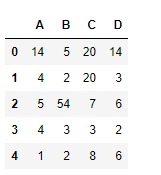Python是进行数据分析的一种出色语言,主要是因为以数据为中心的python软件包具有奇妙的生态系统。 Pandas是其中的一种,使导入和分析数据更加容易。
Pandas dataframe.mode()函数获取沿所选轴的每个元素的模式。为每个标签的每种模式添加一行,并用nan填充空格。请注意,对于选定的轴,可能返回多个值(当一个以上项目共享最大频率时),这就是返回数据帧的原因。
用法: DataFrame.mode(axis=0, numeric_only=False)
参数:
axis: get mode of each column1, get mode of each row
numeric_only: if True, only apply to numeric columns
返回值:模式:DataFrame(排序)
范例1:采用mode()函数在索引轴上查找模式。
# importing pandas as pd
import pandas as pd
# Creating the dataframe
df=pd.DataFrame({"A":[14,4,5,4,1],
"B":[5,2,54,3,2],
"C":[20,20,7,3,8],
"D":[14,3,6,2,6]})
# Print the dataframe
df
让我们使用dataframe.mode()函数查找数据帧的模式
# find mode of dataframe
df.mode()输出:

范例2:采用mode()在列轴上查找模式的函数
# importing pandas as pd
import pandas as pd
# Creating the dataframe
df=pd.DataFrame({"A":[14,4,5,4,1],
"B":[5,2,54,3,2],
"C":[20,20,7,3,8],
"D":[14,3,6,2,6]})
# Print the dataframe
df
让我们使用dataframe.mode()查找模式的函数
# axis = 1 indicates over the column axis
df.mode(axis = 1)输出:

在第0和第3行中,模式14和3是出现的次数最多的模式(即2)。在该列的其余部分,所有元素均为模式,因为它们的发生频率相同。
相关用法
- Python pandas.map()用法及代码示例
- Python Pandas Series.str.len()用法及代码示例
- Python Pandas.factorize()用法及代码示例
- Python Pandas TimedeltaIndex.name用法及代码示例
- Python Pandas dataframe.ne()用法及代码示例
- Python Pandas Series.between()用法及代码示例
- Python Pandas DataFrame.where()用法及代码示例
- Python Pandas Series.add()用法及代码示例
- Python Pandas.pivot_table()用法及代码示例
- Python Pandas Series.mod()用法及代码示例
- Python Pandas Dataframe.at[ ]用法及代码示例
- Python Pandas Dataframe.iat[ ]用法及代码示例
- Python Pandas.pivot()用法及代码示例
- Python Pandas dataframe.mul()用法及代码示例
- Python Pandas.melt()用法及代码示例
注:本文由纯净天空筛选整理自Shubham__Ranjan大神的英文原创作品 Python | Pandas dataframe.mode()。非经特殊声明,原始代码版权归原作者所有,本译文未经允许或授权,请勿转载或复制。
